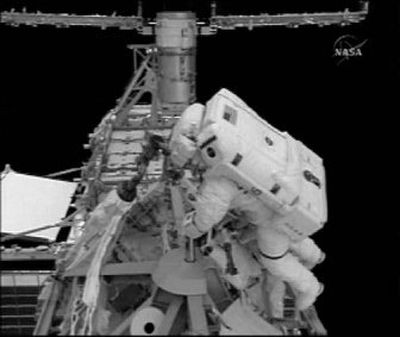U.S. astronauts set space-walking records

CAPE CANAVERAL, Fla. – Astronaut Michael Lopez-Alegria broke the U.S. record for most time walking in space Thursday as he and another astronaut did maintenance work outside the international space station during their third spacewalk in nine days.
Lopez-Alegria surpassed the previous U.S. record of 58 hours and 32 minutes midway through his chores with fellow American Sunita Williams. He has a ways to go to claim the all-time record, though – Russian Anatoly Solovyov has logged more than 82 hours.
The 6 1/2 -hour spacewalk ended at 12:06 p.m. PST.
“They were all three extremely difficult (spacewalks), and you guys made them look not necessarily easy, but the way they should look,” Mission Control said. “You did an excellent job.”
Lopez-Alegria and Williams finished a primary mission of the their spacewalk: tossing quilt-sized thermal sheets from the international space station.
The two large thermal covers were folded up with smaller shrouds that had been covering an electronics box and were used to prevent parts of the space station from getting too hot or cold. Engineers believe they will burn up upon entering Earth’s atmosphere in about three weeks.
“I don’t think I could do it any better than that,” Lopez-Alegria said to Williams as the first package floated away.
Lopez-Alegria joked that they had an easier time folding up the shrouds than their spacewalking colleagues who helped fold up a stubborn solar array during space shuttle Discovery’s mission to the space station last December.
“Solar arrays wish they could retract this well!” he said.
The astronauts also finished hooking up cables to a new system that will allow power from the station to be shared with a docked shuttle so it can stay longer; added a platform that will hold a storage container; and took photos of a docking port.
During the two earlier spacewalks, the astronauts had changed the space station’s cooling system from a temporary system to a permanent one that will allow the addition of new components built by Europeans and the Japanese.
The spacewalk marked the first time three spacewalks have been conducted in such a short period without a space shuttle docked to it. The first two spacewalks had similar tasks, and flight controllers thought they could save preparation time by squeezing them together.
Lopez-Alegria planned to conduct a fourth spacewalk Feb. 22 with Russian flight engineer Mikhail Tyurin.
That spacewalk will be Lopez-Alegria’s 10th. The previous U.S. time record for spacewalks was held by astronaut Jerry Ross, who has made nine.
Lopez-Alegria’s new U.S. record is 61 hours and 22 minutes.